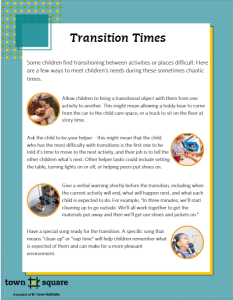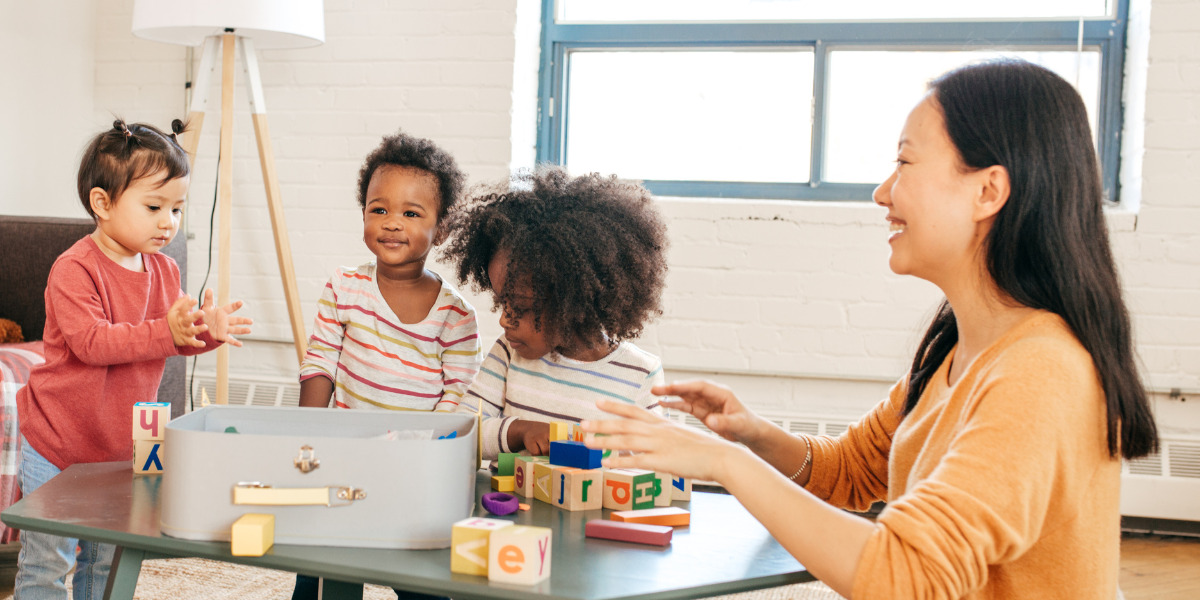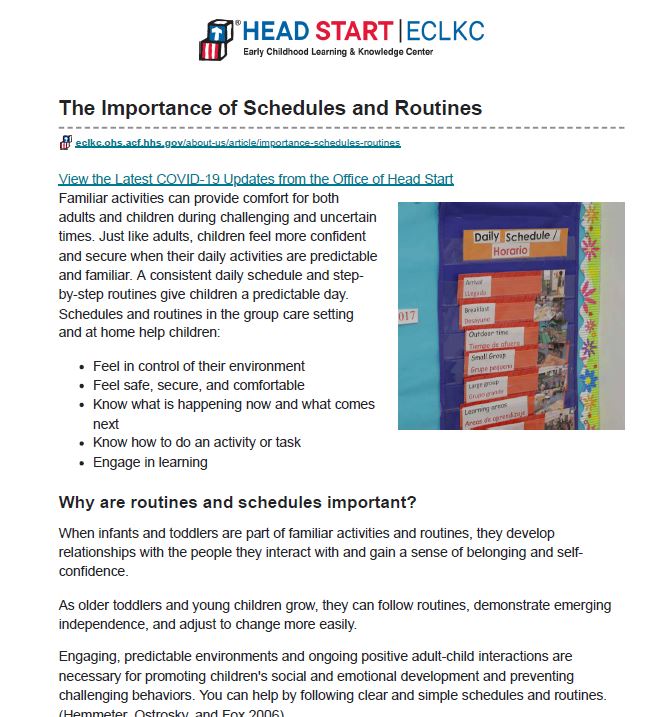This printable tip sheet for transition times offers educators some practical strategies for helping children transition between activities, or from home to school.
In the RIE philosophy, there is a great emphasis on ensuring that caregiving times are relaxed and enjoyable for children and their caregivers. While this might be a dramatic reframe for some– is it really possible to enjoy changing diapers? — it can make mundane tasks much more pleasant.
Family child care is a unique profession– some days drag out, but many others fly by. Taking any opportunity to slow down and be mindfully present with the children is a way to build relationships with each child and ensure that there is time each day spent in warm individual interactions.
The major criterion that makes an activity “want something” quality time is that the adult has an agenda for the child to participate in. This is typically participating in a care task like diapering/toileting, feeding/eating, or dressing. How can these sometimes stressful occasions become enjoyable for everyone? The answer is simple: play!
When a child is getting changed, songs and nursery rhymes (“This Little Piggy”, “Hickory, Dickory, Dock”) have natural gestures that can be incorporated into dressing the child. Taking some pressure off of meals and offering conversation or even calm games for older toddlers, like “I spy on my plate” or discussing the attributes of the meal.
It’s normal for a child to offer some resistance during care times; babies and toddlers try to roll away from diaper changes, or spit out food, or tantrum to avoid getting dressed. Approaching the child in the spirit of collaboration and fun, while not an immediate “cure” for these behaviors, will change the tone of these interactions over time.
Reflection Questions:
- What “want something” times are most difficult right now?
- Consider a child you have struggled to connect with, or who struggles when participating in care tasks: how and when could you use want something quality time to build that relationship?
Creating a sense of place in early childhood programs is crucial for the healthy development of young children. A sense of place refers to children’s physical and emotional connection with their surroundings. Young children need to feel safe, secure, and comfortable in order to learn and grow. By creating a sense of place in early childhood programs, educators can provide children with a nurturing environment where they can learn and explore.
Here are some benefits of creating a sense of place in your program:
- Sense of Belonging: When children feel a sense of belonging in their environment, they are more likely to engage in activities and build relationships with peers and educators.
- Social Emotional Development: A stable and consistent environment can help children feel emotionally secure and give them a sense of predictability, which is important for their emotional wellbeing.
- Physical Development: A well-designed environment can stimulate physical development through exposure to different materials, spaces, and sensory experiences.
- Learning and Exploration: Children who feel comfortable and safe in their environment are more likely to be curious and explore their surroundings. This can lead to richer and more meaningful learning experiences.
- Sense of Ownership and Responsibility: When children participate in designing and maintaining their environment, they develop a sense of ownership and responsibility.
Penn State Better Kid care shares a wonderful resource with tips on how you can create a sense of place.
Creating a sense of place: Considering routine, ritual, and belonging
Schedules and routines help children feel safe and secure by providing them with everyday events and procedures, helping them know what is expected of them, and making their environment more predictable. Head start Early Childhood learning & knowledge center shares the importance of schedules and routines and ways to partner with families to best support children.
The Importance of Schedules and Routines
When preparing children for school, parents and teachers acquire all the tools that will be essential for their success in the classroom. Pencils, paper, crayons, blocks, baby dolls and books are all accessible for making the year successful. They are considered important pieces of the education process.
If you are fortunate enough to have a program that also provides fresh air and time for play outdoors in the winter months, consider yourself extremely lucky! However, your child will need a whole different list of supplies to make sure this time is equally successful.

Clothing is a crucial piece of the outdoor experience!
A few years ago it became clear to me that if I was supplying stumps, loose parts and the time to be outdoors in nature, our program had to have clothing available for backup. Clothing is a crucial piece of the outdoor experience. Teachers often ask me how long it takes to get everyone dressed to go outdoors? Trust me, the time it takes will get shorter and shorter very quickly. And the process is a learning lesson in itself. There is a sequential order involved. It is a lesson in self-sufficiency. What could be a better use of our time? With so many children attempting to get ready at the same time, children learn to independently get ready on their own. Our children love to play in the snow and they know that getting ready is part of the process. A few years ago I had a two year old that could Suit Up and Boot Up faster than her older counterparts.
I am always curious how others make this work in their programs. Like anything else in our classroom, I start with baby steps and tweak it as I go. I encourage you to try and get outdoors every day. It is so good for both our mental and physical health. However, you need the tools for this to be successful. If you have children who don’t bring their “pencils” to class, you must supply them.
Here is our version of Suit Up and Boot Up.
You can do this! Baby steps!
- I start by setting up stations or centers. There are many stages of dress and it can take a lot of space, so offer that space to keep peace in the room and the focus on getting dressed. You don’t want everyone standing on top of each other trying to get dressed. I start at one end of our room and lay the stations out ending at the exit door. You could also do a circle. After a day or two the children will help you lay out the stations.
- After everyone has gone to the bathroom, we are ready to get serious!
- We start with snow pants. Be aware that for some families this is an extra expense that they have not budgeted for or simply don’t understand because the adults quit playing in the rain and snow! We always try to have an extra set or two around. If we supply the blocks and dolls, we also need to supply back up winter clothing for those who don’t have what they need on any given day.
- Then we have stations for their boots, coats, hats and mittens. By now they are standing by the door for the last inspection and the help they may need with zippers, buttons, buckles or mittens.
Car mittens vs snow mittens
Which brings us to mittens or gloves. For the very young, I am a big fan of mittens, just because they are so much easier to get on. As the children get older though, sometimes they just need the flexibility and precision to build or pick things up with gloves. This is where I am on a one-woman campaign for new vocabulary words.

Car mittens vs Snow Mittens (gloves qualify but it ruins my campaign slogan!) Fleece and wool mittens are good for car rides, but if you are going to sled, build snowmen, eat icicles or just PLAY in the snow you need SNOW mittens or gloves. Any waterproof glove or mitten will work, but really great ones go up past your wrist. They allow you to play for longer periods of time and stay warm in the winter temperatures. I knew my vocabulary word was catching on when a four year old sadly walked in the door and announced, “I could only find my car mittens today.” Poor kid. He looked devastated. He knew the consequences. There are of course natural consequences to not wearing the proper clothing. You get wet, cold, tired and very crabby! Many times, children will not remember the snow play from a year ago. This is a brand new experience for them, even if they were outdoors daily last year! We want this to be a successful and enjoyable experience for them. We need to supply the tools for our day to be fun and stress free!
What do you do in the snow?
I often get asked, “What do you do in the snow?” We play! The night before the first predicted snowfall, I retrieve all the sand buckets and shovels and molds. These are great tools to add to snow play. If they are buried or frozen in the sandbox, it is an impossible task. Trust the voice of experience on this one!
Our little friends love to help shovel, build snow friends and snow angels. This is a whole new world of adventure and investigations for them. Just walking or running in snow is a new adventure! We have spent hours searching for ice and then working to remove it from whatever container it may have formed in. Slipping and sliding on ice? Ice skating without the cost of skates! Giggles galore, no broken bones to report! One hard fall will usually send a child off to find something else to do, but there are always a lot more laughs than tears. Trust the child! Jumping off any height only to land in a pile of fluffy white stuff to break the fall, can entertain us for long periods of time. Sliding down snow filled slides or jumping off a swing when the snow is just inches below it, are all new experiences. Finding animal tracks from brave squirrels, hungry birds or the neighbor’s cat can buy us a good half hour of fun. When the winter days are so short that the children are coming to us in the dark, and heading home in the dark, getting outdoors in sunshine or at least daylight is so very good for our mental health.
Don’t forget the clean-up!
After hours of play, the order is reversed. I set up laundry baskets and child size benches outdoors, with the last basket for boots next to the door so they can step right in on a dry floor. The children strip off their clothes and put them in the proper basket. This works well for separating wet clothing and boots away from our dry hats and coats. It also reinforces independence and sequencing as the children try to do this process on their own! (Those snow pants can be ornery sometimes!)
Of course nothing completes outdoor winter play quite like a big warm cup of soup or hot cocoa! If the temperatures cooperate and the sun is warming your soul, try an outdoor lunch. Hot soup, cheese and crackers, apples and carrots and milk! You can do this! Start with little steps and build your way up!
Remember, there is no such thing as bad weather, just bad clothing! It will change your winter play!
Did you ever think about the many opportunities to incorporate math into something like an outing to the park or meal time? This resource was designed to be shared with families, but has plenty of excellent ideas for how to incorporate math into everyday routines and outings in your family child care home. Each idea is connected to a math concept such as number, geometry, spatial sense, or measurement.
Family Note on Finding the Math
Preschool children love to help. You can ask children to create videos or even a series of photos to explain how to do something or even steps or guidelines for a routine activity like handwashing, as this example from a provider illustrates:
Children might like to share ideas about things like how to get ready to go play outside, how to clean up after a meal, what to do with your things when you come in, or any number of other things. You can create a slide show with pictures or post a child-created video to a private YouTube channel to share with families. This appropriate use of technology that features the children in your care is sure to be an exciting activity.
Goal: Involve children in communicating information using technology.



